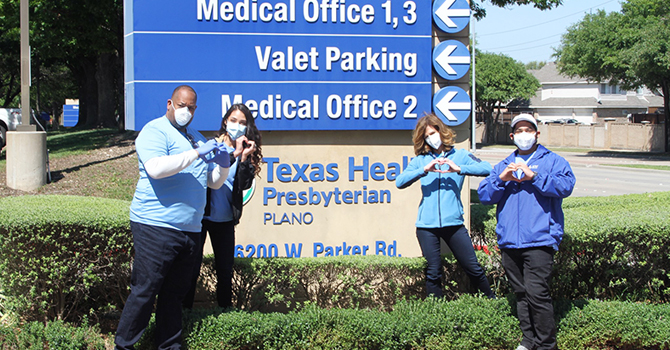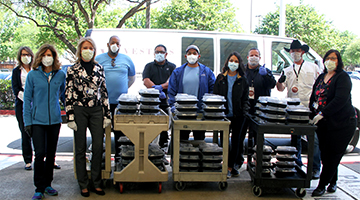Courage and Commitment: Staffing for Crisis Care

Q&A with Kelly Rakowski, MHSA ’93
Group President and Chief Operating Officer, Strategic Talent Solutions, AMN Healthcare
Click Here for the Latest on COVID-19 from Michigan Public Health ExpertsWhat was your role like before the outbreak, and what is it like now? What was the transition like for you, your team, and your organization?
My role at AMN Healthcare is as group president and COO for Strategic Talent Solutions. AMN Healthcare is the largest health care solutions and staffing organization in the US. I am responsible for leading our managed services and strategic sales and our account management teams. We provide work force technology solutions and other strategic outsourcing solutions to support our clients. I still continue in that role but certainly in an entirely elevated level of urgency and focus. We are in true crisis management mode, not unlike many others at this time. At AMN, we saw a significant increase in demand for crisis staffing for all types of clinicians—nurses, doctors, respiratory therapists, and other allied health professionals—plus operational leaders. We also provide a lot of experienced interim leadership around the country.
We saw a significant increase in demand for crisis staffing for all types of clinicians—nurses, doctors, respiratory therapists, and other allied health professionals—plus operational leaders.
By “mobilizing,” do you mean some of these health care workers have shifted work locations or even states? Are you working with out-of-state volunteers?
Between us and our partners, we have mobilized over 10,000 health care professionals since the start of the crisis. We continue to respond to increased demand as different areas of the country and different health systems and communities continuing to experience need. We’re working with several locations to set up and operate what we call “surge facilities,” which for us is about deploying staffing and technology platforms at lightning speed. It is a seven-day-a-week endeavor to provide them with the logistical human and technology resources needed to stand up and staff these health care facilities in very short order. We are all in as an organization, doing whatever we can to step up when our clients need us the most. And though it’s been extremely challenging, it is also incredibly gratifying to see that we have the capability and the commitment to respond to a crisis of this magnitude and be able to support the solutions during this very trying time.
Are these “surge facilities” the makeshift clinics operating in tents, or is it more retooling existing buildings?
It’s been fascinating to see how quickly communities, states, and markets have responded and are finding the right kinds of facilities to expand capacity. We haven’t been directly involved in the decisions or procuring the sites and equipment, but we've put several operational leaders in a position to help plan, implement, and run those facilities and then to staff them. They’ve been everything from hospitals converting some units to hospitals that have recently closed and come back online to converted parking garages, sports arenas, and state fairgrounds. We’re currently supporting convention centers in New York and Michigan. These are open facilities that have the appropriate ventilation, plumbing, and space to accommodate the needs. There has been a real variety and some innovation around redeploying and repurposing different spaces out there.
All hands are on deck to address the crisis.

AMN CEO Susan Salka, AMN team members, and friends recently deliver lunch to the much-deserving staff of Texas Health Plano to show their appreciation.
What has the response meant for regular operations, including medical procedures and providing staff and equipment to carry out those procedures?
Though we are not involved at the clinical, procedural level, we do provide the staffing of all types of clinical care delivery in all settings—hospitals, ambulatory care, post-acute facilities, and even schools. So while we have had high demand for COVID-19 related resources, we did experience declines in other areas of our business. As a company, we retrained and redeployed over 200 of our corporate team members to assist with clinical recruiting, staffing, and credentialing. We also stood up 24/7 crisis teams, revamped internal and external communications, and enabled 100 percent of our workforce to work from home. We also created in a matter of days a COVID-19 website that we continue to manage and update to provide support for our health professionals and clients with relevant data, answers to common inquiries, and other resources. All hands are on deck to address the crisis.
Our aspirations and inspirations have come from tens of thousands of nurses, therapists, physicians, and other professionals who raised their hand to accept assignments at hospitals treating COVID-19 patients.
How important have the new communications platforms you've built been in handling all these new operations?
Communication is the number one need during a crisis. As a national firm, we have to effectively communicate internally to team members across the country and to our clients, especially around credentialing and how to expedite certain things. Many of our deployed staff started facing difficulties traveling home. In a crisis time, you can’t always rely on normal communication channels—they're too slow, they're too fragmented. The ability to communicate at scale and at pace to multiple constituencies has been a really important part of all of these efforts—getting their questions answered, getting the support they need, and the guidance they need—to effectively make decisions.
What is the single biggest challenge you and your organization are facing right now in light of the strains of the pandemic?
The incredible logistical challenge of getting thousands of health care professionals where they need to be, when they need to be there. There are many hurdles to making this happen—finding people to fill the roles, addressing licensure changes, appropriately credentialing, and coordinating travel. The uncertainty in predicting demand also makes it difficult to plan and commit to staff. Finally, the health and safety of our health care professionals is of utmost concern to us. We think about this every day. There's been a lot of coverage in the media about the challenges to getting adequate PPE and protection. We've shared those same challenges along with many other health care organizations. And we openly share PPE access issues and rates of exposure to COVID-19 with our team and with our health care clients.
What are you seeing in the public health response to the pandemic that gives you the most hope?
Through the challenges, our aspirations and inspirations have come from tens of thousands of nurses, therapists, physicians, and other professionals who raised their hand to accept assignments at hospitals treating COVID-19 patients. They are fully aware of the circumstances. They know the risks of what they’ll be facing. Their willingness to accept those really tough assignments knowing they're going into some of the hardest hit areas and higher risk areas and treating those patients is an incredible testament to the courage and commitment of our health care professionals.
We liken it to what the first responders were to the tragedies of 9/11. They're running into the buildings when everybody else is trying to get out. That's what our health care workers are doing.
This has been an incredible movement across the nation. When the crisis first hit and we started hearing about some of the demand, it was daunting. The supply of workers has come from many different areas. One of our primary businesses is around supplying nurses and allied healthcare professionals to use in exactly situations like this, but not usually at this level. We’re working primarily with registered nurses, respiratory therapists, and other allied health professionals moving across state lines and going to where the needs are. We've also seen a number of workers come from off the sidelines. We call them “hand-raisers.” These are professionals either retired or out of the workforce for various reasons who have come forward to say, “I have the skills, I have the experience, and I want to be part of supporting people’s needs.” We partnered with various organizations in areas of the country where services have been shut down and workers have been furloughed to redeploy furloughed nurses who wanted to go to New York, Michigan, and California. Because of the limitations on contact with people throughout the process, many of these workers have had little to no contact with their families. These are the stories that have kept so many of us going.
We liken it to what the first responders were to the tragedies of 9/11. They're running into the buildings when everybody else is trying to get out. That's what our health care workers are doing. Our communities know how important health care workers are and how they are—under normal circumstances—often overlooked, taken for granted. The outpouring of support, emotion, and gratitude for them on social media, with special food deliveries, and so on has been wonderful to see. It's a privilege to work with these folks on a daily basis. Hopefully, this deep understanding of and appreciation for health workers will carry over, and we won't see them ever taken for granted again in the future.
Top photo: AMN Healthcare team members show their thanks to the incredible health care workers caring for communities in Texas and around the country.
- Interested in public public health? Learn more today.
- Listen to Kelly Rakowski on the Population Healthy podcast.
- Read more about Kelly Rakowski in Leading Health Care in Disruptive Times.
- Support research at Michigan Public Health.
